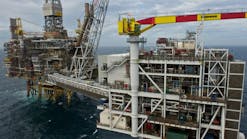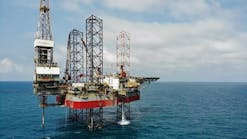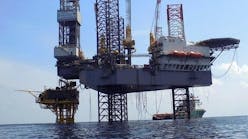Offshore staff
ALTON, UK -- Drilling of the Whirlwind prospect west of Shetland has been halted prematurely, due to incoming wintry weather.
The semisub Borgsten Dolphin started work on well 205/21a-5 on Aug. 22, but the rig has now been released.
Whirlwind, operated by Hurricane Exploration, is 12 km (7.5 mi) north of the company’s 2009 Lancaster oil discovery. Its mapped structural closure – around 40 sq km (15.4 sq mi) – suggests the structure is double in size compared to Lancaster.
The well was designed to evaluate the hydrocarbon and reservoir potential of the Lewisian basement by intersecting two basement fault zones identified within structural closure from seismic mapping.
Hurricane says so far, that the well has penetrated 137 m (449 ft) total vertical thickness (TVT) of fractured basement, which appears to be fractured, according to wireline and drilling data, particularly over the penetrated fault zone.
The potential for a hydrocarbon column is supported by gas chromatography and gas peaks, which Hurricane says are depth consistent with identified fractured intervals.
Overlying the basement is 132 m (433 ft) TVT of hydrocarbon-bearing fractured limestone. Sidewall cores and logging data suggest that although the limestone itself is non-porous, there are permeable fractures present.
Hurricane says further work will be needed to evaluate the reservoir potential of the limestone’s fracture system. But data in so far warrants a resumption of drilling at a later date to acquire further formation evaluation.
The company is satisfied at having reached the current drilled depth, in view of the fact that Whirlwind is deeper lying than Lancaster and in an area having limited basement penetrations.”
Hurricane has also provided an update on its Lancaster sidetrack (well 205/21a-4z). Here the main aims were to confirm that dry oil could be produced from the basement reservoir at commercial rates; to establish hydrocarbon column thickness within closure; and to analyze the disposition of any associated water.
The sidetrack penetrated the reservoir to a TD of 21 m (68.9 ft) above structural closure. It encountered 113 m (370.1 m) TVT of oil-bearing fractured basement. Apart from one water-bearing fracture, the penetrated fluid column was oil saturated.
Subsequently, the water-bearing fracture was isolated during wireline operations, suggesting that water zones can be accommodated in any development wells.
The Lancaster reservoir appears to be significantly more fractured than anticipated. The volume outside of structural closure comprises vertical fault-zones containing either oil or formation water.
Recoverable oil volumes within structural closure will likely be higher than previous estimates, but further detailed analysis concerning recoverable oil outside of structural closure will be needed.
Third-party analysis of the Lancaster drill stem test data suggests that drilling damage to the fractures negatively impacted the maximum measured flow rate of 2,500 b/d of oil. This, combined with evidence of good permeability away from the damaged well bore, indicates that individual well flow rates of over 15,000 b/d could be sustained using current production drilling and completion techniques.
In the same area, Hurricane has the Typhoon oil-bearing basement prospect, which is geologically analogous to Lancaster and Whirlwind.
10/19/2010




